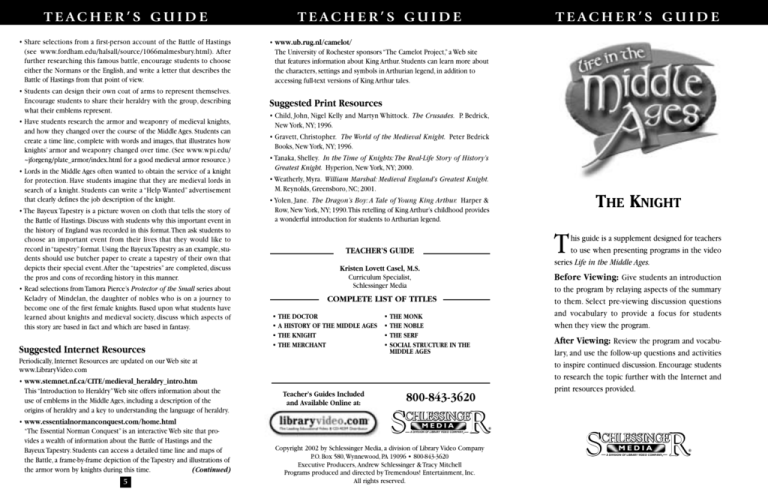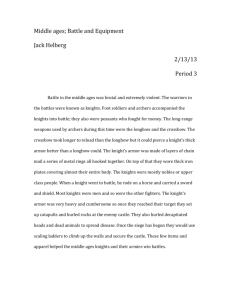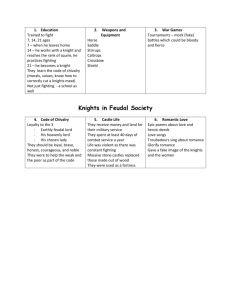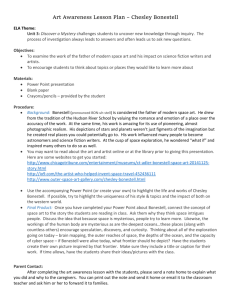
TEACHER’S GUIDE
TEACHER’S GUIDE
• Share selections from a first-person account of the Battle of Hastings
(see www.fordham.edu/halsall/source/1066malmesbury.html). After
further researching this famous battle, encourage students to choose
either the Normans or the English, and write a letter that describes the
Battle of Hastings from that point of view.
• Students can design their own coat of arms to represent themselves.
Encourage students to share their heraldry with the group, describing
what their emblems represent.
• Have students research the armor and weaponry of medieval knights,
and how they changed over the course of the Middle Ages. Students can
create a time line, complete with words and images, that illustrates how
knights’ armor and weaponry changed over time. (See www.wpi.edu/
~jforgeng/plate_armor/index.html for a good medieval armor resource.)
• Lords in the Middle Ages often wanted to obtain the service of a knight
for protection. Have students imagine that they are medieval lords in
search of a knight. Students can write a “Help Wanted” advertisement
that clearly defines the job description of the knight.
• The Bayeux Tapestry is a picture woven on cloth that tells the story of
the Battle of Hastings. Discuss with students why this important event in
the history of England was recorded in this format.Then ask students to
choose an important event from their lives that they would like to
record in “tapestry” format. Using the Bayeux Tapestry as an example, students should use butcher paper to create a tapestry of their own that
depicts their special event.After the “tapestries” are completed, discuss
the pros and cons of recording history in this manner.
• Read selections from Tamora Pierce’s Protector of the Small series about
Keladry of Mindelan, the daughter of nobles who is on a journey to
become one of the first female knights. Based upon what students have
learned about knights and medieval society, discuss which aspects of
this story are based in fact and which are based in fantasy.
• www.ub.rug.nl/camelot/
The University of Rochester sponsors “The Camelot Project,” a Web site
that features information about King Arthur. Students can learn more about
the characters, settings and symbols in Arthurian legend, in addition to
accessing full-text versions of King Arthur tales.
Suggested Internet Resources
Periodically, Internet Resources are updated on our Web site at
www.LibraryVideo.com
• www.stemnet.nf.ca/CITE/medieval_heraldry_intro.htm
This “Introduction to Heraldry”Web site offers information about the
use of emblems in the Middle Ages, including a description of the
origins of heraldry and a key to understanding the language of heraldry.
• www.essentialnormanconquest.com/home.html
“The Essential Norman Conquest” is an interactive Web site that provides a wealth of information about the Battle of Hastings and the
Bayeux Tapestry. Students can access a detailed time line and maps of
the Battle, a frame-by-frame depiction of the Tapestry and illustrations of
the armor worn by knights during this time.
(Continued)
5
TEACHER’S GUIDE
Suggested Print Resources
• Child, John, Nigel Kelly and Martyn Whittock. The Crusades. P. Bedrick,
New York, NY; 1996.
• Gravett, Christopher. The World of the Medieval Knight. Peter Bedrick
Books, New York, NY; 1996.
• Tanaka, Shelley. In the Time of Knights: The Real-Life Story of History’s
Greatest Knight. Hyperion, New York, NY; 2000.
• Weatherly, Myra. William Marshal: Medieval England’s Greatest Knight.
M. Reynolds, Greensboro, NC; 2001.
• Yolen, Jane. The Dragon’s Boy: A Tale of Young King Arthur. Harper &
Row, New York, NY; 1990.This retelling of King Arthur’s childhood provides
a wonderful introduction for students to Arthurian legend.
T
his guide is a supplement designed for teachers
to use when presenting programs in the video
series Life in the Middle Ages.
TEACHER’S GUIDE
Kristen Lovett Casel, M.S.
Curriculum Specialist,
Schlessinger Media
Before Viewing: Give students an introduction
to the program by relaying aspects of the summary
to them. Select pre-viewing discussion questions
and vocabulary to provide a focus for students
when they view the program.
COMPLETE LIST OF TITLES
• THE DOCTOR
• A HISTORY OF THE MIDDLE AGES
• THE KNIGHT
• THE MERCHANT
Teacher’s Guides Included
and Available Online at:
• THE MONK
• THE NOBLE
• THE SERF
• SOCIAL STRUCTURE IN THE
After Viewing: Review the program and vocabulary, and use the follow-up questions and activities
to inspire continued discussion. Encourage students
to research the topic further with the Internet and
print resources provided.
MIDDLE AGES
800-843-3620
CHLESSINGE
S
THE KNIGHT
MEDIA
A DIVISION OF LIBRARY VIDEO COMPANY®
R
Copyright 2002 by Schlessinger Media, a division of Library Video Company
P.O. Box 580,Wynnewood, PA 19096 • 800-843-3620
Executive Producers, Andrew Schlessinger & Tracy Mitchell
Programs produced and directed by Tremendous! Entertainment, Inc.
All rights reserved.
®
S
R
CHLESSINGE
MEDIA
A DIVISION OF LIBRARY VIDEO COMPANY®
®
Program Summary
squire — A knight-in-training.A squire learned the skills of knighthood by
Knights are well-known and well-loved characters from fairy tales and
legends — but what was the real story of these warriors of the Middle Ages?
The knights of the 800s wore chain mail, fought on horseback and used a
sword and lance for weapons.As time progressed, they began to wear plate
armor over chain mail and to use weaponry like battleaxes and maces in
addition to swords and lances.To serve as a knight during the Middle Ages
was expensive, and so many knights developed relationships with lords —
the lords offering lucrative lands, the knights providing military protection.
An unwritten law guided the behavior of medieval knights — the code of
chivalry, which stipulated their honor, bravery, generosity and compassion. In
order to become a knight, young boys served an existing knight and became
his squire, until they were dubbed knights themselves. After their dubbing
ceremonies, knights practiced their battle skills in competitions known as
tournaments. By the 1400s, the knight’s military value began to wane with
the introduction of gunpowder. Despite this decline, the knight, with his suit
of shining armor, has been firmly entrenched in our imaginations as the pinnacle of gallantry and bravery.
Vocabulary
knight — A warrior of the Middle Ages who fought on horseback. Knights
were often taken into the service of a lord, whom they swore to serve by
fighting their lord’s enemies.
Middle Ages — Also known as the medieval period, the time period that
stretched roughly from the 5th to the 15th century.The term was coined to
describe the era in between the time of ancient Rome and the Renaissance.
armor — A protective covering for the body, worn by knights during the
Middle Ages to shield them during battle.
lance — A long spear that was carried by medieval knights on horseback
during battle.
chain mail — Protective armor worn by medieval knights that was made of
rows and rows of tiny metal rings linked together.
Battle of Hastings — A battle that took place in 1066 to determine the
ruler of England.The English, led by Harold II, were defeated by the Normans,
led by William, Duke of Normandy.
Bayeux Tapestry — A medieval embroidery that depicts the Battle of
Hastings in 1066.
chivalry — The code of conduct followed by medieval knights. Chivalry
described the qualities that a knight should have, like respecting the Church,
being brave and acting with courtesy.
troubadours — Traveling medieval musicians.
crossbow — A weapon used during the Middle Ages that shot arrows called
bolts.These bolts could be shot right through a knight’s protective chain
mail.
plate armor — Protective armor worn by medieval knights that was made
of large pieces of metal linked together.
longbow — A weapon used during the Middle Ages that consisted of a
wooden bow that shot arrows.
(Continued)
2
serving an existing knight.
dubbing ceremony — The event at which a squire became a knight. At
this time, the newly dubbed knight was presented with his armor.
Crusades — A series of wars fought between Christians and Muslims during
the 11th to the 13th centuries in the hopes of taking possession of Jerusalem
and other places considered to be holy by the Christians.
tournaments — Simulated battles that trained knights for warfare and
enabled them to practice their skills.
jousting — Fighting on horseback with lances, with the goal of knocking
the opponent from his horse.
battleaxe — A weapon used during the Middle Ages that consisted of an axe
with a double-sided blade.
mace — A weapon used during the Middle Ages that consisted of a heavy
club, which was often spiked.
surcoat — A cloak often worn by medieval knights over their armor.
heraldry — The use of symbols or emblems during the Middle Ages. Knights
often wore these emblems on their shields, cloaks and cloths draped over
their horses.
Pre-viewing Discussion
• Knights are often immortalized in fairy tales and legends as triumphant
heroes, fighting the bad guy. Brainstorm with students the connotations
that the word “knight” has for them. Encourage students to indicate the
origins of these meanings (i.e. specific legends, fairy tales, movies).
• Medieval knights were trained fighting men who swore to do battle with
their lords’ enemies. Have students discuss what the presence of a trained
fighting force might tell them about society during the Middle Ages.
• Knights during the Middle Ages followed a code of chivalry that guided
their actions. Encourage students to discuss why it might have been important for knights to adopt a code of chivalry. Do students think chivalry still
exists today?
• Medieval tournaments were simulated battles that trained knights for
warfare, but eventually they became a form of entertainment, attended by
large groups of people. Have students compare tournaments in the Middle
Ages to similar forms of entertainment today.Why do students think that
events like these are popular and have been enjoyed by people for so many
years?
Focus Questions
1. Describe chain mail, and explain its importance for medieval knights.
2.What does the Bayeux Tapestry tell us about the Middle Ages?
3. How did medieval knights obtain the money they needed to pay for their
horses, armor and weaponry?
4.What was chivalry, and how did it affect the behavior of medieval knights?
5.Why did knights start wearing plate armor, and how did this change affect
knights?
(Continued)
3
6. Describe the training process for becoming a knight.
7.What was a dubbing ceremony, and what were some of the key elements of this event?
8.What role did medieval knights play in the Crusades?
9. How did the nature of tournaments change over time?
10.Who was William Marshal, and why was he considered one of the most
amazing knights who ever lived?
11.What was heraldry and how did it play an important role in medieval
tournaments?
12.Why did the popularity of using knights in battle decline by the 1400s?
Follow-up Discussion
• Have students debate whether or not they feel that knights of this time
truly followed their code of chivalry. Encourage students to justify their
answers.
• Students can compare and contrast knights of the Middle Ages with
fighters of today. How are our modern-day methods of defense similar to
and different from medieval methods?
• Encourage students to discuss the pros and cons of becoming a knight.
Do they feel that the glory of being a knight outweighed the costs?
• Have students discuss the relationships that developed between knights
and lords during the Middle Ages, emphasizing the costs and benefits for
each of the participants.
• The majority of medieval knights were male. Based upon what students
have learned about the Middle Ages, discuss why women did not often
fill this role in society.
Follow-up Activities
• The stories of King Arthur have inspired the imaginations of people for
centuries. Share selections from King Arthur legends, and encourage students to discuss what can be learned about the Middle Ages from these
stories. (See sunsite.berkeley.edu/OMACL/Lancelot/ for legends written
by Chrétien de Troyes, or www.lib.rochester.edu/camelot/geofhkb.htm
for those written by Geoffrey of Monmouth.) Then students can use
what they’ve learned about medieval knights to write their own King
Arthur tales.
• Encourage students to write their own modern-day code of chivalry that
could serve as a guide for their behavior today. Compare this modern
code to the code of the medieval knights. (See www.wmich.edu/
medieval/mdvl145/resource/chivalry.htm for an example of a medieval
code of chivalry.)
• Conduct a class research project on the Crusades. Small groups can each
be responsible for one of the eight major medieval Crusades between
1095 and 1291.To present the information that they have researched,
groups can act as newspaper reporters and write articles that detail the
“who, what, when, where and why” of these wars.
(Continued)
4





